Foreign Insulators
by Marilyn Albers
Reprinted from "INSULATORS - Crown Jewels of the Wire", February 1982, page 7
More About British Porcelain Insulators
Last month,
if you will recall, we talked at length about AI (Allied Insulators) Industrial
Products Inc., located in Great Britain. This large diversified company produces
porcelain insulators of many types, and other electrical equipment used the
world over. Just as a review, let me point out again that the formation of the
present day company took place in 1959 with the amalgamation of two existing
companies -- Bullers Ltd. (dating back to 1840) and Taylor Tunnicliff &
Company Ltd. (founded in 1867).
Mr. N. R. Woodward (Houston, Texas) returned
home from a trip to England recently and brought back such a wealth of
information concerning these two companies, including their catalogues, that I
would like to share some of it with you in greater detail. For now, I will zero
in on Bullers Ltd., and save Taylor Tunnicliff Ltd. for a later date.
Again, in
review, you remember that the story of Bullers began in 1840 with the foundation
of a small family pottery business by Mr. John Buller in the village of Bovey
Tracy in Devon, England. Though the firm produced only kiln
"furniture" in the beginning, with the coming of the electrical age
the company moved to the center of the pottery industry, Hanley in
Stoke-on-Trent, and began producing electrical insulators. By the year 1868 it
was an established supplier of insulators, complete with iron work. In 1885 the
metal foundry of Jobson Brothers at Tipton in Staffordshire was purchased, and
the new company, Buller, Jobson & Company Ltd., was formed.
In 1890 the firm
became a public company, and the name was changed to Bullers, Ltd., and this
company, along with Taylor Tunnicliff & Company Ltd., merged to form AI
Industrial Products Inc. Now we have come full circle!
The drawings of the
porcelain insulators that follow are from a Bullers catalogue put out by their
London office at the time the company was still called Buller, Jobson &
Company, which means the date was somewhere between 1885 and 1890. All of these
insulators were available upon order by the customer. Though I did not include
them, the catalogue also showed drawings of shackles, terminal insulators,
bobbins, "leading in" insulators, battery stands and telephone
fittings. You will notice the drawings are shown without threads, even though
all were threaded, with the exception of 467 (underarm insulator) and 581 (knob
insulator). At least I am assuming this to be true, since too many threaded
specimens have been found to deny that fact. Also note the ones that were, or
could be made, in two pieces if desired 430, 470, 476 and 521. It is
interesting, too, to see that they used the word "shed" where we would
say skirt or petticoat.
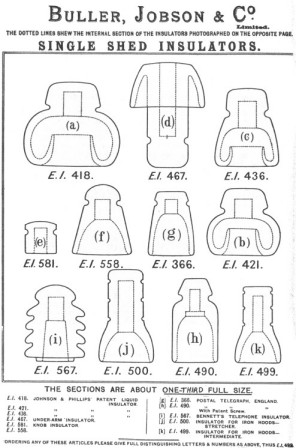
Medium Image (100 Kb)
Large Image (201 Kb)
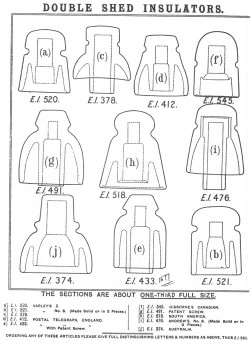
Medium Image (92 Kb)
Large Image (201 Kb)
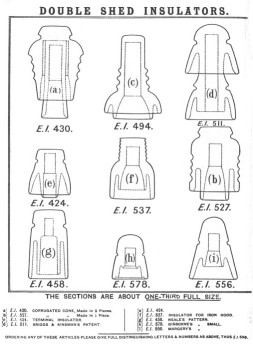
Medium Image (82 Kb)
Large Image (182 Kb)
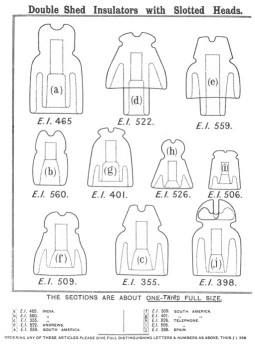
Medium Image (79 Kb)
Large Image (168 Kb)
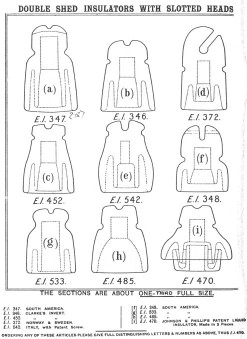
Medium Image (85 Kb)
Large Image (193 Kb)
One thing that really intrigued me was seeing that 499,
500 and 537 were porcelain inserts made for use with an outer iron hood! The
November 1980 issue of Crown Jewels (page 8) carried a picture of some very old
telegraph insulators used on the Overland Telegraph Line (1872) between
Adelaide and Darwin in Australia. These insulators had outer iron hoods or
shells with inner skirts of porcelain! They were referred to as the armoured
type. In the one that I have the porcelain part is nearly all broken away, so
that I cannot tell you whether or not it was marked in any way. This is an
extremely heavy old insulator, still on the original metal pin, and I would not
part with it for anything! However, it is entirely possible that Bullers
supplied the porcelain inserts for these. Why not? Australia was part of the
Commonwealth, and certainly many styles of British insulators have been found
there.
Also notice 374. Looks familiar, doesn't it? You and I have been thinking
all along that this old telegraph insulator was made in Australia because it is
so commonly found there, and is certainly different in shape from most
insulators we think of as appearing English. But here it is in Bullers
catalogue! I wonder why none of these were marked.
Now take a look at 545. This
is listed in the catalogue as Gisborne's Canadian. I have one just like it with
the incuse marking BULLERS LTD, LONDON. It has taken on new dignity since all
this information has come to light!
To find British made insulators in Canada
and Australia should not surprise us, because they were part of the
Commonwealth, but it is a bit of a revelation to see that way back in 1895
Bullers was supplying insulators to South America, India, Spain, Norway, Sweden
and Italy! Check your foreign porcelains against these drawings. Maybe some of
your Italians, Indians and Swedes have English blood!
Mr. Woodward has in his
possession an old advertisement for railway insulators manufactured by Bullers
Ltc., which states that the company supplied insulators and fittings for
conductor rail and overhead systems in Argentina, Brazil, Bolivia, Chile, India,
Poland and South Africa. Since Bullers made insulators for railway
electrification, and so does one of the divisions of AI Industrial Products Ltd.
today, this would be a good time to show you a chart that Mr. Woodward put
together for us on British Railways. Beside being a topnotch authority on
insulators, he is also quite a Railroad Buff! He and his British friend, David
Benny, followed many miles of track, and combed railroad yards to get pictures
and gather information, and generally had a "jolly good time"! His
explanation follows the chart.
| If you have seen porcelain insulators from England, you
have probably seen some of them marked GPO. That's General Post Office;
those are telephone insulators. However, in many cases, insulators made
for the railways also had the users' initials placed on them. With the aid
of the accompanying chart*, we will explain a little about British
Railways and the earlier companies that made up the present nationalized
system. |
|

Large Image (119 Kb)
|
|
At the outset, railways were privately
constructed and operated: and there were many of them. In 1923, following World
War I. most of the railways operating throughout England, Scotland and Wales
were grouped into four separate regional companies. This grouping was ordered by
parliament to stabilize the impossibly fragmented industry.
At the present time,
most of the insulators we have seen are marked with initials matching the
companies formed in 1923. We have also a sample marked BR(W), which would be a
later one made after 1948.
On the chart, we have listed some of the earlier
companies, including the larger ones. As time passes, it is entirely possible
that insulators will be found corresponding to some of these. Note that the
Great Western Railway existed long before the 1923 grouping. It is, therefore,
possible that GWR insulators could pre-date 1923! The letter W following the
name indicates that line operated in Wales: S indicates Scotland.
When the
railways were nationalized by act of parliament in 1948, six operating regions
were designated, as shown. There have been some changes as regards individual
rail routes: but basically that's the picture today. Unfortunately, there is
very little open wire in service now. communication and signal circuits are
carried in heavily insulated cables laid in covered concrete troughs at
trackside!
*Condensed from information courtesy of David Benny, railway
historian living at Derby, England.
|

At left is a picture of two "for
real" red porcelain insulators used with power supply wires on British
railroad signal circuits. The two differ slightly, but are both considered to be
Bullers #1 style, and bear the incuse Bullers trademark on the crown tops. The
insulator shown at the left is quite a bright red, has a slightly recessed inner
skirt, and was manufactured in 1969. This, being ten years after the merger of
Bullers and Taylor Tunnicliff, would indicate that the new company, AI
Industrial Products Inc., continued to use the Bullers trademark. The insulator
on the right is a darker red, has a slightly extended inner skirt, dates from
1939, and in addition to the Bullers trademark, the incuse letters LMS for
London Midland & Scottish Railway (See chart).
These insulators were brought
back from England by Mr. Woodward and are considered quite rare. They will be on
display at the National Show in Cedar Rapids, Iowa, in July. A little bird told
me he may have one or two extras if you are swift! Many thanks to Mr. Woodward
for all this good information.
|
